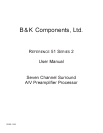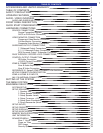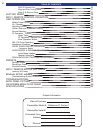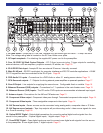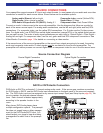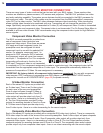
AUDIO / VIDEO OVERVIEW
Definitions
Sources - A source is considered to be any device that can be connected to the audio/video receiver or
processor and transmit a signal that can be seen or heard. Typical sources include DVD players, satellite
boxes, CD players, etc. Your preamplifier can provide audio from its built-in AM/FM tuner. Your preamplifier is
designed to accommodate a wide range of audio and video signals.
Zone - A zone is usually a room or section of the house that has speakers and/or video installed in it. Your
preamplifier includes a full preamp/processor for Zone A , the main theater zone, plus an additional analog
audio and video preamp for Zone B - the second zone. Two zones allow for watching a Dolby Digital movie in
the main theater while simultaneously using the built-in AM/FM tuner in the second zone.
Amplifier - An amplifier takes the output of a pre-amplifier/processor and increases its levels necessary to
drive a speaker. In a receiver the amplifier is combined into the same box with the processor. B&K employs
high current amplifiers in their receivers. These amplifiers are also available as separate components.
Speakers - A surround sound system typically uses 5 speakers located left front, center front, right front, right
surround, and left surround plus a subwoofer located anywhere in the room. With the new developments in
surround technology from companies such as Dolby Laboratories and DTS, it is now possible to improve
spatial expressions with an additional channel of information for use with a 6
th
or 7
th
surround back
speaker(s). Although best results are achieved using seven large speakers plus a subwoofer, this is not
always practical. Excellent results can be achieved using small and/or fewer speakers, as long as you go
through the setup procedures described later in the manual. Your processor includes the capability of repro-
ducing up to 7.1 channels of surround information.
A/V Preamplifier - An A/V preamplifier has the capability to select from a number of A/V sources, adjust
volume levels and route the audio to an amplifier and video to a video monitor. An A/V preamplifier requires
the use of an external power amplifier.
Surround Processor - A processor typically includes the capability to decode one or more surround formats,
and convert between digital and analog as required. Your A/V preamplifier includes a high quality Motorola
TM
processor capable of decoding the various audio surround formats.
Composite video vs. S-video vs. Component video - Composite video is the oldest standard for color
video. It combines the luminance (brightness or black-and-white) and chrominance (color) information onto a
single conductor. At the monitor, this composite video signal must be separated again for it’s display which
results in some degradation of the original video quality. S-video is a standard that uses separate conductors
for the luminance (Y) and chrominance (C) information resulting in better video quality. Component video is a
form of video which first became popular with the introduction of the DVD player. Most component video
signals are a variation of the red, green and blue signals that make up a television image. The simplest type,
RGB, consists of the three discrete R, G & B signals sent over three video cables. Another type consists of R-
Y, B-Y and Y (also known as YUV), sent over three video cables. Y is the luminance channel, R-Y is the red
component minus the luminance information, and B-Y is the blue component minus the luminance informa-
tion. Your preamplifier is capable of switching composite, S-video and component video signals, and
converting between signal types. Your A/V preamplifier is capable of transcoding composite video and S-
video to component YUV video signals.
Transcoding - Video transcoding is the process of converting one video format to another. Video
transcoding is a new technology brought about by the need to integrate these many different video formats.
Video transcoding does not change the resolution of the original video signal and allows different video
formats to be viewed on one video monitor. Video transcoding research is being driven by the need to
integrate video technologies pertaining to computer networks, cell phone, PDAs, television and satellite. Your
A/V preamplifier is capable of transcoding composite video and S-video to component YUV signals.
5



